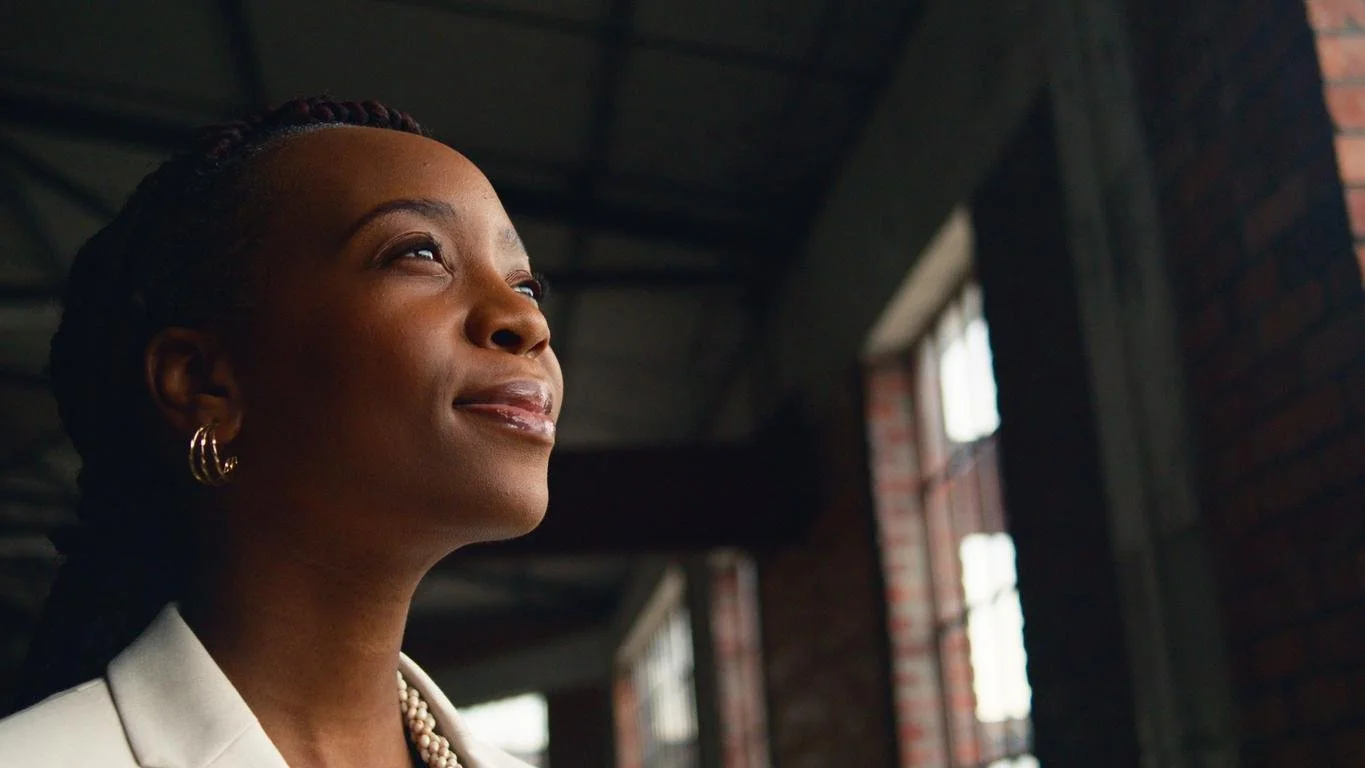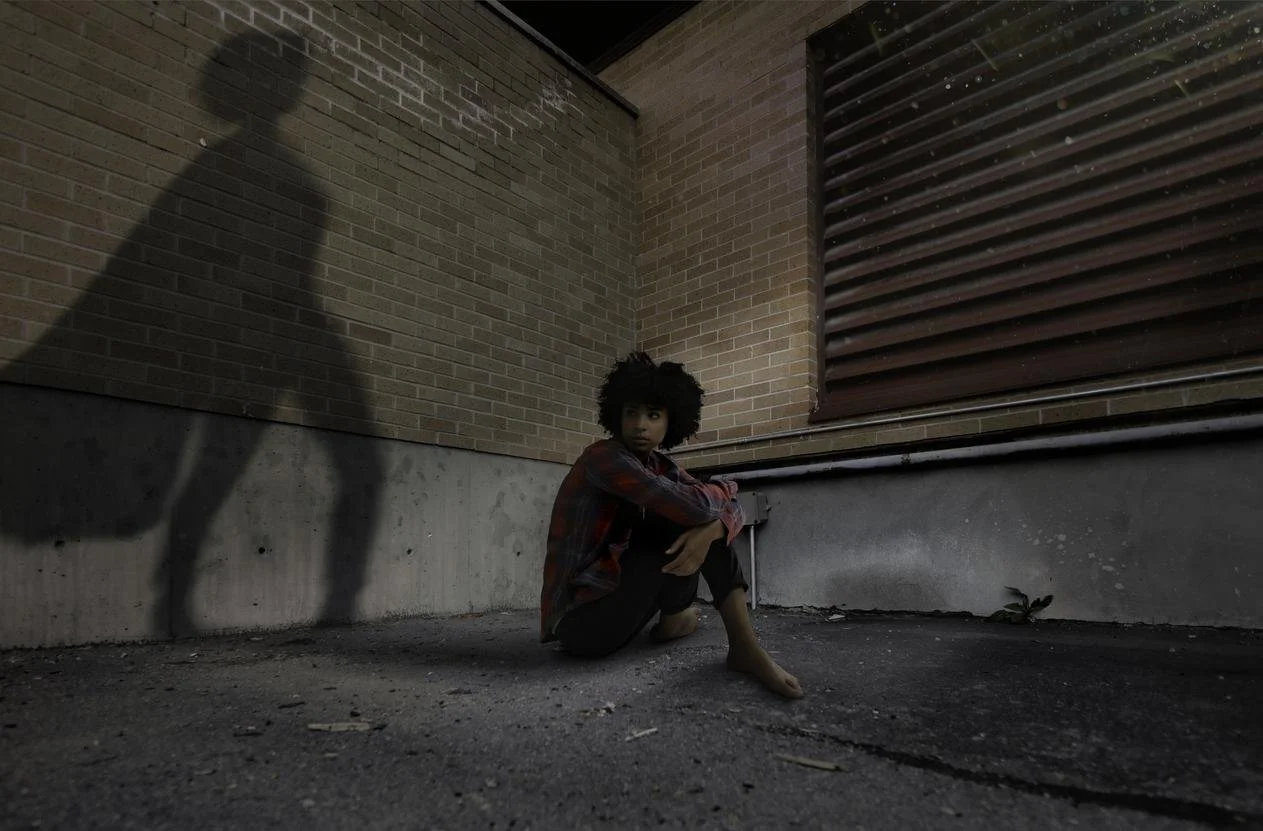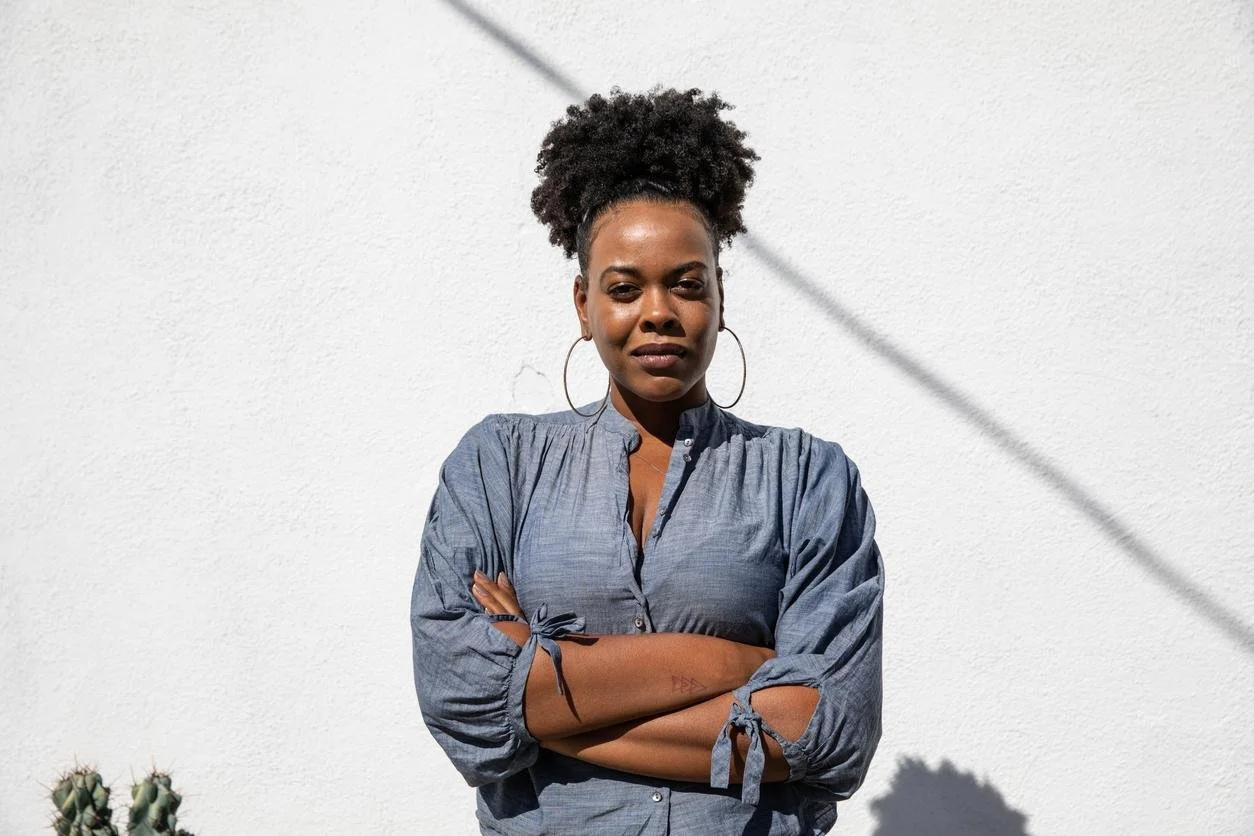I Don’t Know Who Needs to Hear This, But…
Feeling emotionally exhausted is valid, especially for Black individuals navigating strength, survival, and unspoken burdens—this is your reminder that rest, softness, and being enough without performing are all your birthright. We discuss it here!
Photo Credit: Boogich via iStockPhoto.com
By: Jamila Gomez
You don’t have to keep pretending that you’re okay just because people are used to you being strong.
I don’t know who needs to hear this, but your exhaustion makes sense. Not just the physical kind—the soul kind. The kind of tired that doesn’t go away after one good night’s sleep. The kind that lingers after you’ve checked off every box but still feel like you’re falling short.
This world asks a lot of you. And if you’re Black, it asks for even more—your time, your brilliance, your patience, your resilience—and rarely pauses to return the favor. You’re expected to be dependable even when no one checks to see if you’re depleted. And you’ve probably learned how to smile through it. To keep showing up. To hold space for others when no one holds space for you.
But what about you?
You, who is grieving things you never got to name.
You, who is tired of performing strength while no one sees your softness.
You, who doesn’t feel good enough—even when you’re doing more than most.
Let me say this clearly: You are not weak for feeling weary. You are human.
Feeling tired doesn’t mean you’re doing something wrong. It might just mean you’ve outgrown the life you had to build just to survive. It might mean your spirit is asking for more rest, more truth, more honesty. Not just naps and spa days—but real permission to not always be okay.
You are not behind. You are not broken. You are not less than.
You are carrying more than most people will ever see. And even if no one claps for you today, even if no one texts to check in, even if no one says “I’m proud of you”—you’re still doing something sacred.
You’re surviving systems not made for you.
You’re trying to heal without a map.
You’re showing up in rooms that weren’t designed with your rest in mind.
That deserves more than just validation. It deserves relief.
So, if no one has told you lately: You matter. You’re allowed to pause. You are enough—right now, without proving a thing.
You don’t need to be everyone’s anchor. Sometimes, you just need to float.
And maybe this is your permission to do just that.
YOU MAY ALSO BE INTERESTED IN:
SHARE TO SOCIAL MEDIA
Stay the Course: Remember Why You Started
Reignite your passion and stay the course by reconnecting with your "why," overcoming setbacks, and pushing forward toward your dreams with resilience and purpose. We discuss it here!
Photo Credit: valentinrussanov via iStockPhoto.com
By: Jamila Gomez
Life has a funny way of testing you when you’re chasing a dream. That passion that once lit a fire in your soul can sometimes feel like a burden when challenges come knocking. The excitement you had when you started can fade under the weight of doubt, exhaustion, and the pressure to make things happen—especially in a world where Black excellence is expected to be twice as good just to be considered enough.
But let’s pause for a second.
Think back to why you started. What was the vision that kept you up at night? What was the dream that made you step out in faith, despite the odds? That fire you felt in the beginning is still there—it’s just waiting for you to fan the flames again.
The Weight of the Journey
Let’s be real: sometimes the journey is heavier than expected. Maybe you launched your business, but the sales aren’t rolling in the way you hoped. Maybe you started school, but the workload is pushing you to your limit. Maybe you set out to create change in your community, but the resistance has you wondering if it’s even worth it.
We’ve all been there.
The pressure, the setbacks, the moments of doubt—it’s easy to lose sight of the original vision when you’re knee-deep in the process. But don’t let temporary obstacles make you forget the long-term goal. You didn’t start just to quit.
Reconnect with Your “Why”
When the road gets tough, it’s time to ground yourself in your “why.”
• Remember who you’re doing it for. Is it for the little kid who looks up to you? The ancestors who paved the way? The future generations who deserve to see what’s possible?
• Revisit the passion. What made you excited in the first place? Sometimes, stepping away from the grind to reflect can reignite that passion.
• Acknowledge your progress. You may not be where you want to be yet, but you’re not where you started either. Celebrate the wins, no matter how small.
Keep Going—Your Future Self is Counting on You
Success isn’t about avoiding obstacles—it’s about pushing through them. Every great Black entrepreneur, artist, activist, and leader we admire had moments where they wanted to quit. But they didn’t. They kept showing up, pushing forward, and staying the course.
And now it’s your turn.
So take a deep breath, straighten your crown, and remind yourself: You are capable. You are worthy. And you didn’t come this far just to come this far. Keep going.
YOU MAY ALSO BE INTERESTED IN:
SHARE TO SOCIAL MEDIA
Black Burnout Is Different
Black burnout goes beyond workplace exhaustion—it's cultural fatigue, emotional trauma, and the relentless pressure to perform, making rest and systemic change essential for healing. We discuss it here!
Photo Credit: FG Trade
By: Jamila Gomez
Burnout is a buzzword now—plastered across social media, dissected in think pieces, and casually mentioned in Zoom calls like an annoying guest who refuses to leave. Everyone is exhausted. Everyone is overworked. Everyone is running on fumes. But for Black folks, burnout hits different. It’s not just the exhaustion of too many emails, back-to-back meetings, or an ever-growing to-do list. Black burnout is cultural exhaustion. It is the slow erosion of self in a world that demands your labor, your resilience, and your silence while offering little in return.
The Weight of Representation
For many Black professionals, simply existing in predominantly white spaces is a full-time job. We are expected to be excellent—flawless, really—because mediocrity isn’t an option when you’re “the only” or “one of the few.” Black burnout comes from the constant weight of having to represent an entire race in boardrooms, classrooms, and workplaces where our presence is still treated like a diversity initiative instead of a given.
It’s the extra work of translating, softening, and managing how we are perceived. The pressure to be twice as good for half as much is not just a phrase—it’s an inherited survival tactic passed down from ancestors who knew that one mistake could mean losing everything. That kind of vigilance takes a toll. It eats at the psyche, drains the spirit, and leaves no room for rest.
The Trauma of Witnessing
Black burnout is also tied to what we see and cannot unsee. It’s the ceaseless exposure to racial violence—both historical and present-day—without reprieve. It’s the videos that circulate before we have a chance to opt out, the breaking news alerts that remind us that justice remains a moving target, the performative allyship that flares up and fades just as quickly.
Imagine trying to focus on work while mourning yet another life lost to police brutality. Imagine carrying centuries of generational trauma while expected to smile on a Zoom call. Imagine being told to “take care of yourself” in the same breath that your concerns about systemic racism are dismissed. Black burnout is this contradiction in motion—the expectation to function at full capacity while enduring emotional devastation.
The Cost of Resilience
The world loves Black resilience. It loves our ability to endure, to thrive in the face of adversity, to turn pain into poetry, music, and culture. But resilience is often mistaken for an infinite resource, as if we don’t need rest, care, or protection. The truth is, we are exhausted from being resilient.
Resilience, in the way it is expected of us, is not empowerment—it is extraction. It is the expectation that we will keep pushing forward no matter what, that we will keep showing up, keep leading, keep teaching, keep explaining, keep forgiving, keep doing the work. But what happens when we can’t? What happens when we won’t?
Reclaiming Rest as Resistance
Rest is a radical act for Black people. To rest is to reject the grind culture that was never meant to serve us. To rest is to refuse the idea that we must earn our humanity through endless labor. To rest is to reclaim time, joy, and self-worth from a world that tries to steal them.
Black burnout will not be solved by yoga, deep breathing, or self-care Sundays alone—though those things help. It requires systemic change. It requires workplaces that truly invest in Black employees, not just during Black History Month, but in the policies and culture that shape their daily experiences. It requires a world where Black life is valued, protected, and allowed to flourish beyond survival.
Until then, we must prioritize our own well-being, not as an afterthought but as a necessity. We must give ourselves permission to rest, to disengage, to demand more, and to say no. Because Black burnout is different. And so is the way we must heal from it.
YOU MAY ALSO BE INTERESTED IN:
SHARE TO SOCIAL MEDIA
When You Don’t Get What You Want: The Hidden Blessing in Disguise
Embrace life’s redirection as a path to greater opportunities by shifting your mindset from rejection to trust in the journey’s bigger picture. We discuss it here!
Photo Credit: Jacob Wackerhausen via iStockPhoto.com
By: Jamila Gomez
Life often has a way of throwing unexpected curveballs, especially when you’ve set your sights on something specific—a job, a relationship, a goal—and it doesn’t materialize. The disappointment can be overwhelming, leaving you questioning your worth or abilities. However, what if not getting what you want is the universe’s way of paving the path to something better?
The concept of “redirection, not rejection” offers a powerful shift in perspective. While it’s natural to feel crushed when things don’t go as planned, stepping back and trusting that the bigger picture holds unseen opportunities can be transformative. Often, the things we desperately chase may not align with our long-term happiness, even if they seem ideal in the moment.
The Wisdom of Letting Go
There’s an age-old saying: “When one door closes, another opens.” It’s easy to dismiss as a cliché when you’re grappling with disappointment, but countless stories prove its truth. Think about the times you didn’t get a job you thought you wanted, only to later land one that better aligned with your skills and passions. Or when a relationship ended, and later you found a partner who truly understood and supported you in ways you didn’t know were possible.
These experiences highlight that life often withholds what we want not as a punishment, but as protection. Perhaps that job would have been toxic, or that relationship would have held you back from becoming your best self. When you don’t get what you want, it’s often because there’s something better waiting, though you might not see it right away.
The Power of Trust
Trusting the process doesn’t mean passivity or blind faith. It means acknowledging that your current situation, no matter how painful, is part of a greater journey. Instead of focusing on what you’ve lost, ask yourself: What am I gaining instead? The answer might not be immediate, but in hindsight, the pieces often fall into place.
Consider Thomas Edison, who famously remarked, “I have not failed. I’ve just found 10,000 ways that won’t work.” Every “failure” in Edison’s quest to invent the lightbulb was a stepping stone to ultimate success. Similarly, when you’re denied something, it can propel you toward a path you never considered but one that’s far more fulfilling.
Moving Forward
The key is to remain open to possibilities. Don’t let disappointment cloud your ability to see opportunity. Life is dynamic, constantly changing, and often the things we think we want are merely stepping stones to something greater.
So, the next time you don’t get what you want, pause, breathe, and trust. The universe might be clearing the way for something extraordinary—something that will make you realize why your original plans didn’t work out.
YOU MAY ALSO BE INTERESTED IN:
SHARE TO SOCIAL MEDIA
Body Positivity vs. Body Neutrality: Embracing Both in Self-Love
Discover how blending body positivity and body neutrality can help you foster self-acceptance, resilience, and a healthier relationship with your body. We discuss it here!
Photo Credit: Drs Producoes via iStockPhoto.com
By: Jamila Gomez
Body image conversations have evolved significantly over the years, moving away from narrowly defined standards of beauty toward more inclusive and empowering perspectives. Two concepts that frequently emerge in these discussions are body positivity and body neutrality. While both perspectives aim to dismantle harmful societal messages about appearance, they take slightly different approaches. Embracing elements of both can foster a healthier, more holistic relationship with our bodies.
Body positivity is rooted in the idea that all bodies are inherently worthy of love and respect, regardless of size, shape, ability, or appearance. It challenges narrow beauty norms by affirming that every person deserves to feel good about themselves. This movement encourages people to celebrate their unique features and reject media images that promote a single, often unrealistic standard of beauty. By practicing body positivity, individuals can work toward self-acceptance, self-compassion, and a resilient sense of self-worth.
However, some people find it difficult to maintain an unwavering sense of positivity about their bodies every day. This is where body neutrality comes in. Body neutrality suggests that you do not have to love every aspect of your physical appearance to treat yourself with kindness and respect. Instead, it emphasizes viewing the body as a vessel that performs essential functions, such as breathing, moving, and keeping us alive. The goal is not to celebrate perceived flaws but to reduce the power and pressure we place on them. Body neutrality can be especially helpful for those who struggle with body image, as it offers a gentler alternative to relentlessly striving for self-love.
Embracing both body positivity and body neutrality means recognizing that different situations may call for different approaches. On days when you feel radiant and confident, body positivity can be immensely uplifting. On days when insecurity or comparison creeps in, body neutrality can offer a more accessible, less pressurized path, allowing you to acknowledge your body’s functions without forcing overt praise or enthusiasm.
Ultimately, the goal is to cultivate a stable foundation of self-worth that withstands external influences. Whether you choose to celebrate your appearance wholeheartedly or simply appreciate your body for all it does, giving yourself permission to shift between these two mindsets can be empowering. By blending body positivity and body neutrality, individuals can foster balance, kindness, and resilience in how they see themselves—recognizing not only the beauty within but also the quiet strength that lies in acceptance and self-care.
YOU MAY ALSO BE INTERESTED IN:
SHARE TO SOCIAL MEDIA
Black Women Deserve Grace, Not Criticism
Black women face exhausting double standards in appearance, behavior, and cultural expression, highlighting society's need to dismantle biases and celebrate authenticity. We discuss it here!
Photo Credit: Rawpixel via iStockPhoto.com
By: Jamila Gomez
Black women often endure a unique and exhausting double standard in how their actions, appearance, and behavior are judged compared to women of other races. Despite their resilience and contributions to culture, society, and history, they are frequently ridiculed for things that are celebrated or overlooked when displayed by others.
One of the most glaring examples of this double standard lies in the policing of Black women’s physical appearance. Hairstyles like braids, afros, or locs, which are deeply rooted in Black culture, are often labeled as “unprofessional” or “unkempt” in corporate settings. Meanwhile, these same styles, when adopted by non-Black women, are praised as “edgy” or “trendy.” Similarly, Black women are criticized for their naturally curvier bodies or voluptuous figures, often labeled as “too sexual” or “inappropriate.” Yet, when others undergo cosmetic procedures to mimic these features, it’s deemed desirable and aspirational.
Black women’s assertiveness is also subject to an unfair lens. When they speak up for themselves or express strong opinions, they are often branded as “angry” or “aggressive.” This harmful stereotype of the “angry Black woman” minimizes their voices, making them hesitant to advocate for themselves in professional or personal settings. In contrast, women of other races who exhibit the same assertiveness are more likely to be seen as confident and empowered.
Even in parenting, Black women face harsher judgment. Single Black mothers are disproportionately stigmatized and blamed for societal issues, despite many demonstrating incredible strength and resourcefulness. Conversely, single mothers from other backgrounds often receive sympathy and support, with their struggles seen as individual challenges rather than moral failings.
Additionally, Black women are frequently ridiculed for their cultural expressions, from their vernacular to their style. Terms like “ghetto” are used to demean behaviors or aesthetics that are intrinsic to Black communities, only for those same traits to become celebrated when co-opted by others.
This constant scrutiny creates a societal burden that forces Black women to overperform in nearly every aspect of life just to be granted basic respect. While society has made progress in recognizing these disparities, there is still a long way to go in dismantling the biases that perpetuate these double standards. Black women deserve to live authentically, without fear of judgment for simply being themselves.
YOU MAY ALSO BE INTERESTED IN:
SHARE TO SOCIAL MEDIA
Starting Over: The Glow-Up You Didn’t Know You Needed
Starting over isn't a setback; it's a powerful opportunity to reinvent yourself, drop unnecessary baggage, and embrace new possibilities that lead to growth, resilience, and your ultimate glow-up. We discuss it here!
Photo Credit: PeopleImages via iStockPhoto.com
By: Jamila Gomez
Let’s keep it real—starting over can feel scary as all get-out. You’ve got to leave behind what’s familiar, even if it wasn’t all that great, and step into the unknown. But here’s the thing: starting fresh isn’t a setback; it’s a setup for something better. When life hits you with the “reset” button, that’s your chance to level up, boss up, and rewrite your story the way you want it told.
New beginnings? They’re not a punishment. They’re a blessing in disguise. Let’s break it down—here’s why starting over could be the best thing that ever happened to you.
1. A Fresh Start = A Fresh You
Starting over is like getting a new pair of shoes —you feel lighter, fresher, and ready to step out with confidence. You get to shed all the stuff that’s been holding you back—old mistakes, toxic energy, or even just the version of yourself that didn’t feel like you.
Think of it like this: you’re not starting from scratch; you’re starting from experience. You know what didn’t work last time, and now you’ve got the wisdom to move smarter.
2. Bye Bye, Baggage
Let’s be honest—sometimes we carry too much weight. That dead-end job? Gone. That relationship that had you second-guessing your worth? Bye. The friend that only hits you up when they need something? Let them go.
Starting over is like unpacking a suitcase that’s been way too heavy. Once you drop all that unnecessary baggage, you’ll realize how much faster you can move. Life feels lighter when you stop dragging around what’s not for you.
3. Change Builds Character
Here’s the truth: starting over builds you in ways staying comfortable never could. Change makes you resilient. It makes you sharp. You learn how to hustle, how to adapt, and how to trust yourself when things get tough.
When you start over, you’re stepping into a world of possibilities. Sure, it’s unfamiliar at first, but that’s where the growth happens. You’ll come out on the other side with a story to tell and strength you didn’t even know you had.
4. New Energy, New Opportunities
Sometimes you need a change.. Moving to a new city, changing jobs, or even just shaking up your routine can unlock doors you didn’t even know were there.
New beginnings bring new people into your life—people who see your potential, who hype you up, and who help you grow. And those old dreams you had? Starting over gives you the chance to actually chase them.
5. You Find Your Glow Again
Let’s not forget: starting over gives you a reason to focus on YOU. When you leave behind what’s not working, you make space for what will. You can focus on what makes you happy, what lights you up, and what makes you feel alive.
That glow-up isn’t just physical—it’s mental, emotional, and spiritual, too. You start to feel yourself again, and that confidence? Unstoppable.
6. The Power of Reinvention
The best part of starting over? You get to reinvent yourself. You want to try something new? Go for it. Always wanted to switch careers, dye your hair, or move to a city where nobody knows your name? Now’s the time.
Starting over lets you rewrite your story with no limits. You’re not bound by the past anymore, so dream big and go after it. You’re the author now—write a masterpiece.
7. Inspiring Others Along the Way
When you start fresh, you’re not just helping yourself—you’re showing others what’s possible. People are watching you step out of your comfort zone, take risks, and create a new path, and trust me—they’re inspired.
Your story of starting over might be the push someone else needs to start their own journey. And that’s how you become a walking example of what it looks like to bounce back stronger.
Your Reset, Your Rules
Starting over isn’t a sign of failure—it’s proof that you’re brave enough to chase what’s better for you. It’s not always easy, and yeah, it might get messy, but that’s how beautiful things grow.
So, if life’s giving you a chance to start fresh, take it. Lean into the unknown, trust yourself, and know that the best version of your life is waiting for you on the other side.
You’ve got this. Go build that glow-up, one step at a time.
YOU MAY ALSO BE INTERESTED IN:
SHARE TO SOCIAL MEDIA
Failure Isn’t a Full Stop: Keep Going
Failure is not the opposite of success but a stepping stone to growth, offering valuable lessons that pave the way for future achievements. We discuss it here!
Photo Credit: Meeko Media via iStockPhoto.com
By: Jamila Gomez
First things first: failure doesn’t define you. It’s not the period at the end of your story; it’s a comma. Messed up on a project at work? Got ghosted after putting yourself out there? Launched a side hustle that flopped? Cool. That just means you’re doing something. The people who never fail are the ones who never try.
The trick is to stop seeing failure as a reflection of your worth and start seeing it as part of the process. Every success story you’ve ever heard is full of “almost didn’t make it” moments.
The Lesson in the L
Here’s the secret sauce: failure is only a waste if you don’t learn from it. When something doesn’t work out, ask yourself why. Was it the approach? The timing? The effort? Take a hard look at what went wrong—not to beat yourself up, but to figure out how to move differently next time.
Think about it like this: every time you fail, you’re gathering data. That “bad” relationship taught you what you don’t want. That “lost” job showed you what kind of environment you thrive in. That “failed” business idea taught you a skill you’ll use in your next venture. The L isn’t a loss; it’s a lesson.
Keep It Moving
The key to failing forward is momentum. Don’t let fear of failure paralyze you. If something doesn’t work out, pivot and try again. Successful people aren’t the ones who never fail—they’re the ones who keep going, even after they fall flat on their face.
Picture this: you’re riding a bike. If you stop pedaling, you fall over. But if you keep moving, even at a slow pace, you stay balanced. Life works the same way. Keep pedaling, even when the road gets bumpy.
Failures That Built Legends
Need proof? Look at some of the greatest success stories:
• Michael Jordan didn’t make his high school varsity basketball team on his first try. Now he’s literally synonymous with greatness.
• Oprah Winfrey got fired from one of her first TV jobs. Fired. From a job in the very industry she went on to dominate.
• JK Rowling got rejected by 12 publishers before someone gave Harry Potter a shot. Now it’s a billion-dollar empire.
These people didn’t stop at failure. They learned from it, adjusted, and came back harder.
Rewrite Your Story
Failing forward means giving yourself grace. You’re going to mess up—it’s inevitable. But how you respond to failure is where the magic happens. You can either sit in the wreckage and throw a pity party, or you can sift through the rubble, grab the tools you need, and start rebuilding.
So, the next time you fall short, don’t get stuck. Get up. Look back, take the lesson, and keep stepping forward. Fail forward, and watch how those L’s start looking more like stepping stones.
Because here’s the truth: failure isn’t the opposite of success. It’s a part of it.
YOU MAY ALSO BE INTERESTED IN:
SHARE TO SOCIAL MEDIA
Sis, Save Yourself: The Art of Taking Off the Cape
Black women are reclaiming their well-being by breaking free from the "superwoman" myth and prioritizing self-care, mental health, and personal happiness amid generations of resilience and dedication. We discuss it here!
Photo Credit: pick-uppath via iStockPhoto.com
By: Jamila Gomez
Black women have long been the backbone of their communities, workplaces, and families. They’ve been leaders, nurturers, and supporters, often juggling countless responsibilities while dealing with systemic inequalities and personal struggles. Yet, in their dedication to helping others, Black women frequently place their own needs on the back burner. This tendency to prioritize others’ well-being above their own can come at a significant cost to their mental, emotional, and physical health. Now, more than ever, it’s crucial for Black women to start putting themselves first, embracing self-care, and prioritizing their personal growth and happiness.
For generations, Black women have been conditioned to be “strong” and resilient, qualities often celebrated and admired. However, this “superwoman” archetype, while empowering in some contexts, can also be damaging. It often leads to an unspoken expectation that Black women should handle everything without breaking down. This stereotype places undue pressure on Black women to be the caretakers, the reliable ones, and the problem solvers for everyone else. But constantly carrying this weight can lead to burnout, anxiety, depression, and other health issues.
Putting oneself first does not mean abandoning loved ones or responsibilities. Rather, it means recognizing that personal well-being is essential to be fully present for others. Black women must remember that self-care is not selfish; it’s necessary. When they prioritize their health and happiness, they can engage more meaningfully and sustainably in their relationships and communities.
To begin prioritizing themselves, Black women can establish boundaries. Saying “no” when necessary, delegating responsibilities, and setting limits on their time and energy are critical first steps. They should embrace the idea that their needs are just as important as those they support. Seeking therapy, practicing mindfulness, dedicating time to hobbies, and resting are all valuable practices that can contribute to a healthier, more balanced life.
Another vital aspect of putting oneself first is understanding that vulnerability is not a weakness. It’s okay to ask for help, to lean on others, and to admit when things get overwhelming. The myth of having to “do it all” alone can be damaging, leading to isolation and internalized stress. Instead, connecting with supportive communities, friends, and professionals can provide a safe space to share challenges and find encouragement.
Ultimately, prioritizing oneself is an act of self-love and respect. Black women deserve the same attention, care, and compassion they often extend to others. By choosing to put themselves first, they are not only taking a stand for their health but also setting a powerful example for others to value themselves unapologetically.
YOU MAY ALSO BE INTERESTED IN:
SHARE TO SOCIAL MEDIA
Black Joy as Resistance: Embracing Happiness Despite Adversity
Black joy serves as a powerful act of resistance, celebrating the resilience and vibrancy of Black culture while countering systemic oppression. We discuss it here!
Photo Credit: PeopleImages via iStockPhoto.com
By: Jamila Gomez
Black joy is a powerful act of resistance, a deliberate choice to experience happiness in the face of systemic oppression, discrimination, and societal challenges. Historically, Black communities have been marginalized and subjected to systemic inequities, and while the narratives often focus on struggle, survival, and resilience, Black joy brings a transformative dimension to the fight for justice and equity. This joy is not merely about momentary happiness but is a profound assertion of humanity, dignity, and self-worth.
At its core, Black joy resists the notion that pain and trauma should define the Black experience. Throughout history, Black people have found ways to celebrate life despite adversity. Whether through music, dance, food, spirituality, or storytelling, Black joy has always been interwoven with culture and identity. From the rhythms of jazz, soul, and hip-hop to the laughter shared at family gatherings and the joy expressed in Black art, each act of joy is a reminder of the richness of Black culture and heritage. These expressions challenge limiting narratives and reinforce a broader, more authentic view of what it means to live and thrive as a Black person.
Black joy is also an antidote to oppression, a way of reclaiming agency in a world that often tries to strip it away. Rather than passively enduring hardship, embracing joy disrupts narratives of victimhood and instead cultivates strength and resilience. It is a way of saying, “We will not let the weight of injustice rob us of our humanity.” This joyful resistance is evident in the celebration of Blackness, the appreciation of shared history, and the embracing of community. By choosing to revel in the beauty of Black life, Black communities resist systems that have attempted to devalue and marginalize them.
Furthermore, Black joy can create space for healing, community, and solidarity. It allows Black individuals to affirm their identities, celebrate each other’s successes, and draw strength from shared experiences. This joy is contagious, spreading a message that Black lives are not defined solely by struggle but are filled with love, laughter, and triumphs.
In embracing Black joy as resistance, Black communities refuse to be solely defined by their struggles. Instead, they assert a powerful, enduring message: that Black life, in all its beauty and vibrancy, is worth celebrating. Black joy is a testament to the resilience and richness of Black culture, a radiant light that continues to shine, undeterred by adversity.
YOU MAY ALSO BE INTERESTED IN:
SHARE TO SOCIAL MEDIA
Things Fall Apart to Build Back Stronger: The Power of Breakdown and Rebirth
Embracing the cycles of falling apart and rebuilding stronger is key to personal growth, relationships, and societal progress, as breakdowns often precede transformation and renewal. We discuss it here!
Photo Credit: Jacob Wackerhausen via iStockPhoto.com
By: Jamila Gomez
In life, the notion that “things must fall apart in order to be built back stronger” is a theme that echoes in nature, relationships, careers, and even within ourselves. While the process of breakdown can be painful, it is often necessary for transformation, growth, and renewal. Just as seeds must break apart to grow into trees, or as bones that heal after breaking become more resilient, falling apart is a natural step in the cycle of life that allows for greater strength to emerge.
Nature’s Cycles: Destruction as a Precursor to Growth
Nature provides us with countless examples of how breaking down is an essential precursor to growth. Forest fires, for instance, are devastating in the short term, but they play a crucial role in revitalizing ecosystems. The heat of the fire releases nutrients stored in dead trees, allowing new vegetation to flourish. Similarly, volcanic eruptions, which seem to bring destruction, often result in new land formations that support vibrant new ecosystems. In each case, the destruction is not the end, but a necessary stage in the process of renewal.
This cyclical process teaches us that breakdown is not inherently negative. It is often a purging of the old to make room for the new, a reordering of things in a way that allows for something stronger, more sustainable, and more resilient to arise.
Personal Growth Through Breaking Down
Just as with natural systems, people too must go through periods of “falling apart” to emerge stronger. Emotional, psychological, and even physical breakdowns can mark the beginning of profound personal transformation.
When we face difficult moments in life—such as the loss of a job, the end of a relationship, or a health crisis—it can feel like our world is crumbling. But it is often in these moments of vulnerability and uncertainty that we discover inner reserves of strength we didn’t know existed. For instance, someone who has lost their job might initially feel devastated, but the experience can push them to explore passions or talents they had previously ignored, leading them to a more fulfilling career.
In this way, personal challenges force us to reevaluate our lives, shed old habits, and make room for new ways of thinking and living. It is through the cracks in our lives that light gets in, revealing deeper truths about ourselves and what we are capable of.
The Phoenix Metaphor: Rising From the Ashes
The metaphor of the phoenix—a mythical bird that is consumed by flames only to be reborn from its ashes—aptly symbolizes the way people and systems can rise from destruction. In many cultures, this image represents the idea that renewal and rebirth often follow periods of profound breakdown or loss.
In terms of personal growth, the phoenix metaphor reminds us that even when we feel as though we have reached rock bottom, there is an opportunity for renewal. When the familiar falls away, we are presented with a blank slate to build a new version of ourselves, one that is often more self-aware, compassionate, and resilient.
Relationships: Breaking Down to Build Better Connections
In relationships, whether romantic or platonic, breakdowns are often necessary to clear out dysfunctional patterns. Conflict can be painful, but it can also serve as a mirror, reflecting the parts of ourselves and our relationships that need healing or adjustment. Misunderstandings, disagreements, or even temporary separations may reveal underlying issues that, once addressed, can result in a deeper connection.
Relationships that never experience any form of breakdown can stagnate. Just like anything else in life, they require change and adaptation to survive. After weathering challenges, couples or friends often find that they understand each other better, communicate more openly, and emerge with a stronger bond.
Building Stronger Systems
On a larger scale, societal structures and institutions also benefit from breakdowns. Throughout history, revolutions, collapses, and crises have often been necessary to spark significant change. When outdated or oppressive systems fall apart, new opportunities for innovation and equity arise.
For example, the economic collapses that have occurred throughout history—though catastrophic at the time—have often led to reforms that create more sustainable and equitable economic systems. The fall of oppressive regimes has historically made way for more democratic or just governments to emerge. In these cases, the breakdown was not a sign of failure, but rather the first step in building something better.
Embracing the Process of Falling Apart
While it is human nature to fear breakdown, it is crucial to remember that it is part of a necessary process. Resistance to change or to the pain of falling apart only prolongs the process and stifles growth. Embracing the discomfort and uncertainty that comes with breakdowns allows us to move through them with more grace and resilience.
In moments of personal struggle, asking questions like “What can I learn from this?” or “How can this experience make me stronger?” shifts the focus from despair to opportunity. By seeing breakdowns as a natural part of life’s ebb and flow, we open ourselves to the possibility of transformation.
The concept of things falling apart before being built back stronger is one of the most fundamental truths in life. Whether in nature, in our personal lives, relationships, or societal systems, destruction and loss often precede growth, renewal, and a stronger foundation. Though the process can be painful and challenging, it is an essential part of transformation.
Just as trees grow back stronger after a fire, or as we emerge from personal crises with a deeper sense of purpose, breakdowns allow us to evolve into stronger versions of ourselves. By embracing the inevitable cycles of falling apart, we can rebuild with more resilience, wisdom, and strength than ever before.
YOU MAY ALSO BE INTERESTED IN:
SHARE TO SOCIAL MEDIA
Patience: The Art of Waiting Well
Discover how patience and faith work together to help you endure life’s waiting periods, fostering personal growth, resilience, and trust in the right timing. We discuss it here!
Photo Credit: skyNext via iStockPhoto.com
By: Jamila Gomez
Life often feels like a series of waiting rooms—waiting for success, for love, for healing, for answers. In a fast-paced world where instant gratification is the norm, practicing patience and maintaining faith can feel like a tall order. Yet, patience and faith are critical virtues when it comes to enduring life’s inevitable periods of uncertainty and delay. They are not just about waiting passively but about trusting that the right things will unfold at the right time.
Patience: The Art of Waiting Well
Patience is more than the ability to wait; it is the ability to maintain peace and composure during that wait. It is a conscious decision to not let frustration or anxiety take over when life doesn’t move at the pace you want. While the world increasingly encourages us to rush, demanding immediate results and constant forward momentum, patience teaches us that good things often take time to come to fruition.
One of the reasons patience is essential is that it allows time for growth. Just like a seed needs time to grow into a plant, many of the best things in life—whether they be relationships, career success, or personal development—require time and nurturing to mature fully. Rushing through life often results in shortcuts that may offer short-term gratification but fail to provide long-lasting fulfillment. Patience, in contrast, enables us to fully experience the process and become more resilient, wise, and grateful as we wait.
Additionally, patience guards us against making hasty decisions out of fear or impatience. It can be tempting to settle for something less than we deserve when the waiting feels too hard, but those who exercise patience are less likely to compromise on their values, dreams, or standards. They understand that some things take longer to materialize because they are worth waiting for.
Faith: Trusting the Process
While patience helps us endure the wait, faith gives us the strength to believe that the wait is worthwhile. Faith is trusting that good things are on the horizon even when there is no visible evidence to support that belief. It’s the quiet assurance that there is a purpose to the waiting period, even when we cannot see what it is.
Faith helps to counteract the feelings of doubt and fear that can arise during long periods of waiting. It’s easy to feel anxious when things don’t seem to be progressing, or to lose hope when you don’t get the job, the relationship, or the breakthrough you’ve been hoping for. In those moments, faith reminds us that there is a bigger picture at work, one that we may not fully understand but can trust is for our benefit.
This trust doesn’t mean being passive or doing nothing while we wait. On the contrary, faith encourages us to continue putting in effort, believing that our hard work will eventually bear fruit. For instance, someone looking for a job needs both patience and faith. Patience helps them endure the application process without losing hope, while faith reminds them that the right opportunity is out there, even if it hasn’t materialized yet.
The Synergy of Patience and Faith
Patience and faith are complementary virtues that work hand-in-hand to guide us through life’s challenges. Without faith, patience can feel like mere endurance, a passive waiting that lacks hope. Without patience, faith can lead to frustration and despair, especially when things don’t happen as quickly as we expect. Together, they create a powerful mindset that keeps us grounded and optimistic, no matter the circumstances.
When you combine patience and faith, you cultivate an inner strength that allows you to face uncertainty with calm assurance. This combination also fosters gratitude because it shifts the focus from what is missing to what is present. Instead of constantly striving for more, you begin to appreciate the journey, finding peace in the process of becoming rather than just in the outcome.
The most rewarding things in life often take time, and patience and faith are the keys to waiting well. They help us trust in the timing of life and in the goodness that is yet to come, even when the future is uncertain. By embracing these virtues, we allow ourselves the grace to enjoy the journey, knowing that the destination—no matter how long it takes to arrive—will be worth the wait.
In the end, patience and faith are not just about waiting for good things to happen; they are about becoming the kind of person who can receive and appreciate those good things when they finally do arrive.
YOU MAY ALSO BE INTERESTED IN:
SHARE TO SOCIAL MEDIA
You Are More Capable Than You Realize
Discover how you can unlock your hidden talents and embrace your strength within to overcome the challenges of everyday life and thrive despite adversity. We discuss it here!
Photo Credit: JIgor Alecsander via iStockPhoto.com
By: Jamila Gomez
We all have moments of self-doubt, times when the road ahead seems daunting and we question our ability to navigate it. Maybe it's the fear of a new challenge, the weight of past failures, or the sheer uncertainty of the future. Whatever it is, these feelings can make us forget something profound: we are far more capable than we realize.
The Power of Underestimation
One of the most surprising things about human nature is how often we underestimate our own abilities. We see others achieving great things and assume they possess something special that we lack. The truth is, we all have incredible potential within us, often lying dormant, waiting for the right moment to shine. The key is not to wait for a crisis or a major life event to discover this; it’s about recognizing and nurturing our capabilities every day.
Strength Through Struggles
Think back to a time when you faced a challenge that seemed insurmountable. Perhaps it was a difficult project at work, a personal loss, or a time when everything seemed to go wrong. Yet, here you are, having overcome it. You found the strength, resilience, and creativity to get through it, even if it didn’t feel like it at the time. Each struggle you’ve faced has added a new layer to your strength, shaping you into the capable person you are today.
Embracing the Unknown
The fear of the unknown is a powerful force that often holds us back. We hesitate to take that leap, fearing failure or embarrassment. But the unknown is where growth happens. Every great achievement began as a step into uncertainty. When you embrace the unknown, you tap into resources you didn’t know you had. You start to realize that you can adapt, learn, and thrive in ways you never imagined.
The Role of Self-Belief
Believing in yourself is not about arrogance or overconfidence; it’s about recognizing your worth and your potential. It’s about understanding that you have the ability to learn, grow, and achieve whatever you set your mind to. Self-belief is the foundation of resilience. When you believe in yourself, setbacks become stepping-stones, and failures become lessons.
Unlocking Your Potential
To truly unlock your potential, start by setting small, manageable goals. Each time you achieve one, you build confidence. Over time, these small wins accumulate, and before you know it, you’ve climbed a mountain. Surround yourself with people who encourage and support you. Their belief in you will reinforce your own.
Take time to reflect on your achievements, no matter how small they seem. Write them down, celebrate them, and remind yourself of them often. Each one is proof of your capability.
You Are More Than Enough
You are more capable than you realize. Your potential is not something that needs to be discovered; it’s something that needs to be unleashed. It’s within you right now, waiting for you to recognize it, trust it, and act on it. So, the next time you face a challenge, remember that you have already conquered so many before it. You have the strength, the resilience, and the creativity to overcome whatever comes your way. All you need to do is believe it.
Embrace your hidden strengths and watch as you achieve more than you ever thought possible. The world is waiting for your unique contributions. It’s time to show just how capable you truly are.
YOU MAY ALSO BE INTERESTED IN:
SHARE TO SOCIAL MEDIA
The Power of Vulnerability: Turning Perceived Weakness into a Strength
Accepting vulnerability can be a strength that fosters authentic connections, growth and emotional resilience. We discuss it here!
Photo Credit: bloodstone via iStockPhoto.com
By: Jamila Gomez
In a world that often glorifies strength, resilience, and invincibility, vulnerability can feel like an unwelcome guest. We're conditioned to believe that showing our soft spots is a sign of weakness, something to be hidden at all costs. Yet, what if we’ve misunderstood vulnerability all along? What if, instead of being a weakness, vulnerability is one of our greatest strengths?
The Misconception of Vulnerability
For many, vulnerability is synonymous with fear, insecurity, and exposure. It's the feeling you get when you open up to someone about your deepest fears or when you admit that you don’t have all the answers. It’s that moment of raw honesty where your guard is down, and you’re fully seen for who you are—flaws and all.
Because of this, we often go to great lengths to protect ourselves from feeling vulnerable. We put on masks, build walls, and hide behind facades of perfection. But in doing so, we miss out on the profound connections and growth that come from embracing our true selves.
Why Vulnerability Is a Strength
1. Authentic Connections: Vulnerability is the birthplace of authentic relationships. When we allow ourselves to be seen, we invite others to do the same. This openness fosters trust and deepens our connections with others, creating relationships that are not just surface-level but rich and meaningful.
2. Courage to Be Real: It takes immense courage to be vulnerable. To admit that you’re scared, that you’ve failed, or that you need help requires strength of character. This honesty with yourself and others is a testament to your inner resilience, not a lack thereof.
3. Growth and Learning: Embracing vulnerability is essential for growth. When we admit that we don’t know everything, we open ourselves up to learning. Failure, often seen as a byproduct of vulnerability, is a critical part of this learning process. Each misstep is an opportunity to grow, adapt, and come back stronger.
4. Emotional Resilience: Being vulnerable means being in touch with your emotions. Rather than suppressing or ignoring difficult feelings, vulnerability encourages us to confront and process them. This emotional awareness builds resilience, allowing us to navigate life’s challenges with greater ease.
5. Inspiration to Others: When you lead with vulnerability, you inspire others to do the same. Your willingness to be open about your struggles and fears can encourage others to step out of their comfort zones, creating a ripple effect of authenticity and bravery.
How to Embrace Vulnerability
1. Start Small: You don’t have to bare your soul all at once. Begin by sharing small aspects of your true self with those you trust. Over time, as you become more comfortable, you can gradually open up more.
2. Reframe Your Thinking: Instead of seeing vulnerability as a weakness, start viewing it as a strength. Remind yourself that being vulnerable is a courageous act that requires bravery and resilience.
3. Practice Self-Compassion: Being vulnerable means accepting yourself as you are, flaws and all. Practice self-compassion by treating yourself with kindness and understanding, especially when you’re feeling exposed or uncertain.
4. Seek Out Support: Surround yourself with people who value and encourage your vulnerability. These are the individuals who will support you, offer empathy, and remind you of your strength when you need it most.
5. Embrace the Uncomfortable: Vulnerability often feels uncomfortable, but that’s where the growth happens. Lean into that discomfort, knowing that it’s a sign you’re stretching beyond your comfort zone and growing as a person.
Vulnerability is not a weakness to be shunned but a strength to be embraced. It’s the key to authentic relationships, personal growth, and true courage. By allowing ourselves to be vulnerable, we unlock a power within us that transcends fear and insecurity, leading to a life of deeper connections, greater resilience, and genuine fulfillment. So, the next time you feel the urge to hide your vulnerability, remember that it’s not a sign of weakness—it’s a testament to your strength.
YOU MAY ALSO BE INTERESTED IN:
SHARE TO SOCIAL MEDIA
Don’t Go Back to What Broke You
For healing and growth, it is vital to let go of what has hurt you in the past. Refuse to be tempted to return to that pain and embrace your journey towards a healthier and more fulfilling future. We discuss it here!
Photo Credit: Delmaine Donson via iStockPhoto.com
By: Jamila Gomez
Life is a journey filled with twists and turns, some of which can lead us into dark and painful places. Whether it's a toxic relationship, a destructive habit, or an unhealthy environment, many of us have experienced situations that left us broken. The process of healing from these experiences is difficult, but the temptation to return to what once broke us can be even harder to resist. It might seem easier to go back to the familiar, even if it's harmful, rather than face the unknown of moving forward. However, it's essential to remember that going back to what broke you will only hinder your growth and keep you trapped in a cycle of pain.
The Comfort of Familiarity
One of the reasons people are drawn back to what hurt them is the comfort of familiarity. Our brains are wired to seek out what we know, even if it’s not good for us. A toxic relationship, for instance, might feel like home because it’s what we’ve grown accustomed to. The idea of leaving that behind can feel like stepping into a void, where nothing is certain.
However, familiarity is not the same as safety. Just because something is known doesn’t mean it’s good for you. The discomfort of the unknown is a small price to pay for the freedom and peace that comes with leaving behind what broke you.
The Illusion of Change
Another powerful lure to return to what broke you is the hope that things have changed. You might think that people, situations, or environments have improved or that you’ve grown strong enough to handle them differently. While it’s possible for people and circumstances to change, it’s important to be realistic.
Change takes time and effort, and it’s not always guaranteed. More often than not, going back to what broke you means returning to the same patterns and behaviors that caused you pain in the first place. It’s crucial to assess whether genuine change has occurred or if you’re simply holding onto the hope that things will be different this time.
The Cycle of Brokenness
Returning to what broke you often results in a vicious cycle. You find yourself back in the same situations, repeating the same patterns, and experiencing the same pain. This cycle can be exhausting, eroding your self-esteem and making it harder to break free each time.
Breaking this cycle requires courage and a commitment to your own well-being. It means recognizing that you deserve better than the hurtful situations you've experienced and that you have the power to create a different future. By refusing to go back, you disrupt the cycle and open up space for healing and growth.
Self-Worth and Boundaries
Not going back to what broke you is an act of self-love. It’s a declaration that you value yourself enough to protect your peace and well-being. This requires setting and enforcing boundaries, which can be challenging, especially if you’re used to putting others’ needs before your own.
Setting boundaries means understanding your limits and refusing to compromise them, even if it makes others uncomfortable. It’s about prioritizing your mental, emotional, and physical health over the desire to please others or maintain the status quo. In doing so, you create a safer and healthier environment for yourself, one where you can thrive rather than just survive.
The Strength in Moving Forward
Moving forward after being broken is an act of immense strength. It takes resilience to walk away from something that once had a hold on you, and even more strength to keep moving in a new direction. Each step forward, no matter how small, is a victory.
In moving forward, you reclaim your power. You’re no longer defined by what broke you, but by how you chose to rise from it. This journey of self-discovery and growth may be difficult, but it’s also incredibly rewarding. As you move forward, you’ll begin to see the possibilities that lie ahead, rather than the pain that lies behind.
Embracing the Unknown
The future can be daunting, especially when it’s uncharted territory. But it’s in the unknown that we find new opportunities, experiences, and connections that can bring joy and fulfillment. Embracing the unknown means trusting that there’s more for you beyond what broke you—more love, more happiness, and more peace.
While it’s natural to feel fear when stepping into the unknown, it’s important to remember that growth happens outside of your comfort zone. By choosing not to go back to what broke you, you’re giving yourself the chance to grow into the person you’re meant to be, free from the shadows of the past.
Choosing Yourself
At the heart of the decision not to go back to what broke you is a simple yet profound choice: to choose yourself. Choosing yourself means prioritizing your healing, your happiness, and your future over the familiar pain of the past. It’s about recognizing your worth and refusing to settle for anything less than you deserve.
Life is too short to spend it in places or with people that break you. The path forward may be uncertain, but it’s filled with the potential for healing, growth, and joy. So, choose to move forward. Choose to leave behind what broke you. Choose to create a life where you can truly thrive.
YOU MAY ALSO BE INTERESTED IN:
SHARE TO SOCIAL MEDIA
Walking in Purpose Without Seeking Validation
Learn the power of walking in purpose without seeking validation, and learn how to stay true to your calling even when external approval is lacking. We discuss it here!
Photo Credit: CarlosDavid.org via iStockPhoto.com
By: Jamila Gomez
In a world that thrives on likes, shares, and external recognition, it’s easy to fall into the trap of seeking validation. We’re constantly bombarded with images and messages that tell us our worth is determined by how others perceive us. But what happens when the applause fades, when the accolades are few, or when our path is misunderstood? The truth is, the journey of walking in purpose requires a mindset that goes beyond the need for validation.
The Illusion of Validation
Validation feels good—it’s a warm embrace from the world that says, “You’re on the right track.” But relying on it can be a slippery slope. When we seek validation, we often find ourselves swayed by the opinions of others, whether they align with our purpose or not. The danger here is that external validation can become a substitute for internal conviction.
Imagine a seedling growing in a forest. It doesn’t wait for the other trees to give it permission to grow; it pushes through the soil, reaching for the sun, because that’s what it was designed to do. In the same way, we are all designed with a unique purpose. Our growth and success aren’t dependent on the validation of others but on our ability to stay true to that purpose.
Purpose Is Internal, Not External
Your purpose is a deeply personal calling. It’s the reason you were created, the contribution only you can make to the world. This calling doesn’t come with a need for external approval. It’s not about fitting into the mold others have created for you but about breaking out of it to fulfill your unique destiny.
When you walk in your purpose, your focus shifts from “What will people think?” to “What am I meant to do?” This shift is powerful. It frees you from the constraints of people-pleasing and allows you to pursue what truly matters.
Validation Is Fleeting, but Purpose Is Steadfast
The need for validation can be exhausting because it’s never fully satisfied. One day you’re praised, the next you’re criticized. If you base your actions on the reactions of others, you’ll find yourself on an emotional roller coaster, constantly chasing the next high of approval. But purpose is different. It’s a steady, unchanging force that doesn’t waver with public opinion.
Purpose gives you the courage to stand firm in your beliefs, even when others don’t understand. It’s the guiding light that keeps you moving forward, even when the path is lonely. When you embrace your purpose, you develop an inner resilience that’s not easily shaken by external circumstances.
The Power of Internal Validation
Internal validation comes from knowing your worth and your mission. It’s about having a deep, unshakable belief in your abilities and your purpose. This self-assurance doesn’t require constant reinforcement from others because it’s rooted in something far more substantial—your core values, your passion, and your unique gifts.
To cultivate internal validation, practice self-reflection. Take time to connect with your inner self and understand your motivations, strengths, and desires. Celebrate your progress, no matter how small, and recognize the value you bring to the world, independent of anyone else’s opinion.
Walking in Purpose Without Needing Validation
Walking in purpose means taking action aligned with your calling, regardless of who is watching or what they’re saying. It’s about living authentically, making decisions based on your values, and pursuing your goals with passion and persistence.
Here are a few practical steps to help you walk in purpose without seeking validation:
1. Define Your Purpose: Get clear on what you’re here to do. What are your passions? What impact do you want to make? Understanding your purpose gives you a clear direction and a reason to keep going, even when validation is lacking.
2. Set Boundaries: Protect your purpose by setting boundaries. Limit your exposure to negative influences and opinions that may derail you from your path. Surround yourself with people who support your journey, but don’t rely on them for validation.
3. Trust Your Intuition: Your intuition is a powerful guide. Trust it to lead you in the right direction, even when others don’t see the vision. Your purpose is often something only you can fully understand, so give yourself permission to follow your instincts.
4. Celebrate Your Own Wins: Don’t wait for others to acknowledge your progress. Celebrate your milestones and accomplishments, no matter how small. This reinforces your sense of purpose and reminds you that you’re on the right track.
5. Practice Gratitude: Focus on what you have, not what you lack. Gratitude shifts your mindset from seeking external approval to appreciating the journey you’re on. It reminds you that your purpose is a gift, and you’re privileged to live it out.
Walking in purpose without needing validation is a liberating experience. It allows you to pursue your calling with confidence, resilience, and authenticity. When you free yourself from the need for external approval, you unlock the full potential of your purpose. Remember, your worth isn’t determined by how others see you; it’s defined by how true you are to yourself and the unique path you’re meant to walk. Embrace your purpose, and let it guide you—validation will become an afterthought, not a necessity.
YOU MAY ALSO BE INTERESTED IN:
SHARE TO SOCIAL MEDIA
The Power of Learning from Past Mistakes
Embrace your mistakes as essential steps toward growth by reflecting on their lessons, building resilience, and moving forward with renewed purpose and courage. We discuss it here!
Photo Credit: LeoPatrizi via iStockPhoto.com
By: Jamila Gomez
Mistakes. We all make them, sometimes daily. They’re those moments that can make us cringe, feel embarrassed, or wish we could hit the rewind button on life. But what if we reframed how we view our mistakes? What if, instead of seeing them as failures, we began to see them as stepping stones to success, as essential ingredients in the recipe for growth?
The Gift of Reflection
One of the most powerful tools we have as human beings is the ability to reflect. When we take the time to look back at our past mistakes, we’re engaging in an act of self-awareness that is crucial for personal development. Reflection isn’t about wallowing in regret; it’s about extracting wisdom from our experiences.
Think about a time when you made a mistake. Maybe you spoke out of turn in a meeting, made a poor financial decision, or let someone down. Initially, it might feel painful to revisit those moments. However, in that pain lies a lesson. What did you learn about yourself? What would you do differently next time? These questions are the key to transforming a mistake into a learning opportunity.
Mistakes as Teachers
It’s easy to label a mistake as a failure, but what if we started to see mistakes as our greatest teachers? Life doesn’t come with a manual, and the only way to navigate it is through trial and error. Each mistake we make teaches us something invaluable—whether it’s about the world, other people, or most importantly, ourselves.
Consider the mistakes of great inventors, entrepreneurs, and leaders throughout history. Thomas Edison is famously quoted as saying, “I have not failed. I’ve just found 10,000 ways that won’t work.” His perspective is a testament to the power of perseverance and learning. Every “failed” attempt brought him one step closer to success. By embracing mistakes as lessons, Edison was able to invent the lightbulb, forever changing the world.
Building Resilience
Learning from mistakes is not just about gaining knowledge; it’s also about building resilience. Each time we bounce back from a mistake, we strengthen our ability to cope with challenges. Resilience is like a muscle—the more we use it, the stronger it becomes. When we learn to navigate the discomfort of making mistakes, we equip ourselves with the mental and emotional tools needed to face future obstacles with confidence.
Moreover, embracing mistakes as part of the learning process can lead to a more compassionate relationship with ourselves. Instead of harsh self-criticism, we can approach our past missteps with kindness, understanding that making mistakes is a natural part of being human. This shift in perspective allows us to move forward without the weight of guilt or shame, opening the door to self-growth.
Moving Forward with Purpose
The key to truly learning from past mistakes is to use those lessons to inform our future actions. Mistakes should not define us but rather guide us. When we understand where we went wrong and how we can improve, we gain clarity and direction for our journey ahead.
To do this, it’s essential to set intentions for how we want to move forward. What did your mistake teach you, and how will you apply that lesson in the future? By setting specific goals and intentions, we transform our mistakes into catalysts for positive change.
For instance, if a past mistake taught you the importance of time management, you might set a goal to prioritize your tasks more effectively. If you learned the value of patience from a mistake, you might commit to practicing mindfulness in moments of stress. These actions turn lessons into habits, ensuring that our mistakes contribute to our ongoing personal growth.
The Courage to Try Again
Perhaps the most significant lesson that mistakes teach us is the courage to try again. Fear of failure can be paralyzing, but when we’ve already faced and learned from our mistakes, we become less afraid of the unknown. We understand that mistakes are not the end of the road but merely a detour. Armed with this knowledge, we can approach new challenges with confidence, knowing that even if we stumble, we will rise again, stronger and wiser.
Mistakes are an inevitable part of life, but they don’t have to be a source of regret. By embracing reflection, seeing mistakes as teachers, building resilience, moving forward with purpose, and summoning the courage to try again, we can transform our past mistakes into powerful tools for growth. So, the next time you find yourself wishing you could go back and undo a mistake, remember that every misstep is an opportunity to learn, grow, and become the best version of yourself. After all, it’s not our mistakes that define us, but how we rise after falling.

































